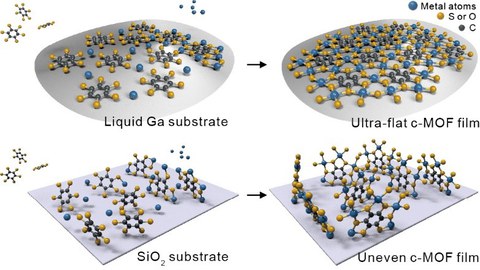28.03.2024
On-liquid-gallium surface synthesis of ultra-smooth thin films of conductive metal-organic frameworks
Two-dimensional conjugated metal-organic frameworks (2D c-MOFs) refer to a class of layer-stacked conductive MOFs linked by square-planar complexes with in-plane π-extended conjugation and out-of-plane van der Waals interaction. The unique charge transport properties and the structural/compositional diversity result in 2D c-MOFs with numerous intriguing physical properties, further enabling them for broad (opto-)electronic applications. However, the currently synthesized 2D c-MOF films suffer from rough film surface (root-mean-square roughness (Rq) ranges from 20 to 103 Å) owing to the poor controllability of precursor nucleation. Researchers from the group of Prof. Xinliang Feng and collaborators a general chemical vapor deposition (CVD) method based on an on-liquid-gallium surface synthesis (OLGSS) strategy for the growth of nine representative ultra-smooth 2D c-MOF thin films with the Rq down to ~2 Å, signifying at least ten-fold improvement in surface flatness compared to the reported works. As proposed by the theoretical calculations, the surpassing adsorption capacity of the adsorbed aromatic ligands with face-on orientation on the Ga surface ensures the formation of the initial flat 2D c-MOF layer. Furthermore, the high adhesion energy between 2D c-MOF layers and Ga permits the film growth following the layer-by-layer mode, thereby yielding a uniform thin film with ultra-smooth surface. Owing to the highly improved interface contact, the contact resistance in the integrated devices of OLGSS films can be reduced by more than 10 times compared to that of the samples synthesized by reported method. In addition, the van der Waals heterostructures (vdWHs) constructed by few-layer OLGSS 2D c-MOF layer and monolayer MoS2 reveal large modulations of the photoluminescence (PL) properties and work function (WF), which highlights the potential of OLGSS films as building blocks for creating unique vdWHs and uncovering novel interfacial phenomena. This work develops a robust OLGSS strategy that affords a feasible access to versatile operable 2D c-MOF films with ultra-smooth surfaces as well as their vdWHs and breaks one synthetic bottleneck of conductive MOFs for (opto-)electronic devices.
Reference: Jinxin Liu, Yunxu Chen, Xing Huang, Yanhan Ren, Mike Hambsch, David Bodesheim, Darius Pohl, Xiaodong Li, Marielle Deconinck, Bowen Zhang, Markus Löffler, Zhongquan Liao, Fengxiang Zhao, Arezoo Dianat, Gianaurelio Cuniberti, Yana Vaynzof, Junfeng Gao*, Jingcheng Hao, Stefan C. B. Mannsfeld, Xinliang Feng*, Renhao Dong*. On-liquid-gallium surface synthesis of ultrasmooth thin films of conductive metal–organic frameworks. Nat. Synth. (2024). DOI: 10.1038/s44160-024-00513-9.
Acknowledgements: This work was financially supported by National Natural Science Foundation of China (22272092), ERC starting grant (FC2DMOF, number 852909), ERC Consolidator grant (T2DCP), SFB-1415 (number 417590517), GRK2861 (number 491865171), EMPIR-20FUN03-COMET, and by the German Science Council, Center for Advancing Electronics Dresden (CFAED). This project has received funding from the European Research Council (ERC) under the European Union’s Horizon 2020 research and innovation programme (ERC grant agreement number 714067, ENERGYMAPS). We acknowledge the European Synchrotron Radiation Facility (ESRF) for provision of synchrotron radiation facilities and we thank O. Konovalov for assistance and support in using beamline ID10. We acknowledge Elettra Sincrotrone Trieste for providing access to its synchrotron radiation facilities and for financial support under the IUS internal project. We thank L. Barba for assistance in using beamline XRD1. We acknowledge Dresden Center for Nanoanalysis (DCN) at TUD. R.D. thanks the Taishan Scholars Program of Shandong Province (tsqn201909047) and the Natural Science Foundation of Shandong Province (ZR2023JQ005). We thank Z. Wang for his help with TEM measurements. J.L. gratefully acknowledges funding from the Alexander von Humboldt Foundation.

